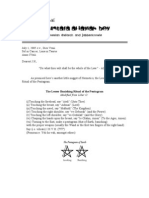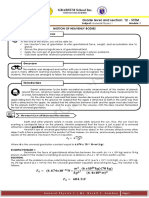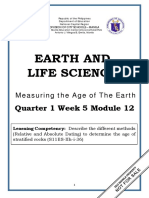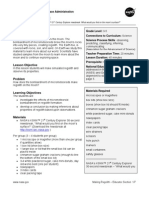Impactcraters
Impactcraters
Uploaded by
JayCopyright:
Available Formats
Impactcraters
Impactcraters
Uploaded by
JayOriginal Title
Copyright
Available Formats
Share this document
Did you find this document useful?
Is this content inappropriate?
Copyright:
Available Formats
Impactcraters
Impactcraters
Uploaded by
JayCopyright:
Available Formats
Exploring Meteorite Mysteries
Lesson 6 Impact Craters “Where
Holes in the Ground! do they
come
Objectives
Students will: from?”
• model impact craters in the lab.
• identify various structures caused by the cratering process. About This Lesson
This lesson allows students to
• manipulate the conditions that control the size and create impact craters in plaster
appearance of impact craters. of Paris or layered dry
• state the relationships between the size of the crater, size of materials. They perform
the projectile, and velocity. controlled experiments by
varying the velocity or mass
• demonstrate the transfer of energy in the cratering process.
of an object and observing
and measuring the effects.
Background
Impact craters are formed when pieces of asteroids or comets strike
the surface of a planetary body. Craters are found on all the terrestrial Vocabulary
planets, on the Earth’s Moon, and on most satellites of planets. crater, impact, projectile,
velocity, kinetic energy, mass,
Various geological clues and studies of the lunar rocks returned by gravity, ejecta, rim,
the Apollo missions indicate that about 3.9 billion years ago meteor
asteroid-size chunks of matter were abundant in the solar system.
This was a time of intense bombardment of the young planets,
affecting Earth by breaking up and modifying parts of the crust.
Mountain building, plate tectonics, weathering and erosion have
largely removed the traces of Earth’s early cratering period. But the
near absence of weathering on the Moon has
allowed the evidence of this ancient time to
be preserved. ejecta
Impact craters are formed by the transfer of
energy from a moving mass (meteorite) to a
stationary body (planet). Kinetic energy is
the energy of motion. It is defined as one
half the mass of an object, times the velocity
of the object squared (K.E. = 1/2 Mv2).
Objects in space move very fast, so this can
be a huge amount of energy! In an impact
the kinetic energy of a meteorite is changed rim
into heat that melts rocks and energy that
pulverizes and excavates rock. Simplified
NASA EG-1997-08-104-HQ Lesson 6 Impact CratersHoles in the Ground! 6.1
demonstrations of this transfer of energy can be made by creating impacts in powdered materials. If
identical objects are impacted into powdered materials from different heights or using different propul
sion systems to increase velocities, then students can determine the effect velocity has on the cratering
process. Likewise if projectiles of different masses are impacted from the same height and the same
velocity, students will be able to identify the relationship of mass to crater formation.
The high velocity impact and explosion of an iron meteorite about 30 meters in diameter could make a
crater over one kilometer wide. This is how Meteor Crater in Arizona was formed. In the classroom
the low velocities and low masses will make craters much closer in size to the impacting bodies.
Energy Calculations for Advanced Classes
K.E. = 1/2 Mv2 (meteorite impacts like Meteor Crater)
v= 2gh (free fall)
K.E. = kinetic energy
thus
M = mass of impacting
object (projectile) K.E. = Mgh (for classroom experiments)
v = velocity of impacting Classroom Experiment Example
object (projectile)
projectile - 10 grams = M
g = gravity constant for drop height - 2 meters = h
Earth (980 cm/sec2) gravity effect - 980 cm/sec2 = g
h = height of release of K.E. = 1/2 × 10 grams × 2 × 980 cm/sec2 × 200 cm
impacting object
K.E. = ~ 2 × 106 ergs
erg = grams × cm2 × sec
(measure of K.E.)
Meteor Crater Estimate
projectile was 30 meters in diameter
iron nickel sphere (meteorite with a density of 8 g/cm3)
projectile 1.1 × 1011 grams = M
4/3 Π (1.5 × 103)3 cm3 = v
(1.4 × 1010 cm3) = v
K.E. = 1/2 Mv2
K.E. = 1/2 × 1.1 × 1011 grams × (2 × 106)2
K.E. = ~ 2 × 1023 ergs
6.2 Lesson 6 Impact CratersHoles in the Ground! NASA EG-1997-08-104-HQ
Lesson 6 Impact CratersHoles in the Ground!
Activity A: Making Craters in Plaster of Paris
About This Activity
Objectives In this activity students create
Students will: impact craters in plaster of
Paris. They may perform
• produce easily recognizable crater forms.
controlled experiments by
• simulate impacts into wet materials.
varying the velocity or mass
of an object and observing the
Procedure
effects.
Advanced Preparation
1. Assemble materials.
2. Practice mixing plaster of Paris to get a feel for the hardening Materials for Activity A
time under classroom or outdoor conditions. Plaster for class ❑ plaster of Paris
room use should be mixed at time of demonstration.
❑ 1 large disposable pan or
3. Copy one Student Procedure per group.
box (if used as a whole
4. If Lesson 7 will not be completed, then consider whether crater
slides could be used in this lesson. class demonstration)
5. Prepare plaster or direct students to mix plaster. or 3-4 small and deep
containers such as
• Mix the plaster of Paris. A mixture of two parts plaster of margarine tubs or loaf
Paris to one part water works best. REMINDER: The plaster pans (for individuals or
hardens in 10 to 20 minutes, so you must work quickly. Have groups)
Data Chart complete and all materials assembled before ❑ mixing container
plaster is mixed. ❑ stirring sticks
• Pour a 5 cm or more layer of plaster in a small deep ❑ water (1 part water to two
disposable container.
parts plaster)
• Optional: Using a kitchen strainer or a shaker, sprinkle a thin
❑ projectiles (marbles,
layer of powdered tempra paint over the plaster (use a dust
mask and do not get paint on clothes). pebbles, steel shot, lead
fishing sinkers, ball
Classroom Procedure bearings)
1. Discuss background before or during activity. ❑ dry tempra paint,
2. Students work in small groups or conduct classroom (optional) red or blue
demonstration. (enough to sprinkle over
3. Follow Student Procedure. the surface of the plaster)
4. Discuss questions. or substitute baby pow
der, flour, corn starch,
fine-colored sand, pow
dered gelatin, or cocoa
❑ strainer, shaker or sifter to
distribute paint evenly
❑ meter stick
❑ Student Procedure (pgs. 6.5
6.6, one per student)
❑ dust mask
❑ Data Charts (pg. 6.9, one
per group)
NASA EG-1997-08-104-HQ Lesson 6 Impact CratersHoles in the Ground! 6.3
About This Activity
Students do controlled cratering Lesson 6 Impact CratersHoles in the Ground!
experiments in dry materials. Activity B: Making Craters in Dry Materials
They vary the impactor
velocity or mass and observe
and measure the effects. Objectives
Students will:
Materials for Activity B
❑ large tray or sturdy box 8-10 • manipulate the variables of velocity and mass to investigate
cm deep and about 1/2 m crater formation.
on each side (a cat litter • recognize the conditions that control the size and appearance
pan works nicely); 2 per of impact craters.
class or 1 per group
❑ baking soda (2-3 1.8 kg- • state the relationships between the size of the crater, size of
boxes) per tray, or flour (2 the projectile, and velocity.
bags, 2.26 kg), or fine sand
(sandbox sand, 3 kg per Procedure
tray) Advanced Preparation
❑ dry tempra paint - red and/or 1. Assemble equipment.
blue; enough for a thin layer 2. Prepare projectile sets and label.
to cover the dry material
surface.(Very fine craft 3. Copy Student Procedure and Data Charts as needed.
glitter may be used as one 4. Prepare target trays of dry material and paint.
color.) A nose and mouth (Optional: students prepare)
dust mask should be used • Place 3 cm even layer of dry material in the bottom of a the
when sprinkling paint. tray (or box).
Suggested substitutes for • Sprinkle a thin layer of red powdered tempra paint over the
paint may be found in the dry material with a kitchen strainer.
materials list for Activity A. • Place another very thin (2-3 mm) even layer of dry material
❑ projectiles (provide one set of on top of the tempra paint, just enough to conceal paint.
either type for each group
• Optional: Sprinkle another layer of blue powdered tempra
of students)
SET A - (provide enough paint on top of the second layer of dry material. Repeat
sets for all groups) four step 6. (Very fine craft glitter can be used in place of
marbles, ball bearings, or tempra paint for “sparkle” effect.)
large sinkers of identical Classroom Procedure
size and weight Note: This procedure is for small groups, it must be modified if
SET B - (provide one or two the entire class will act as a single group.
sets per class) three spheres 1. Students should work in small groups. Each group should
of equal size but different choose at least three projectiles from SET A or SET B.
materials so that they will
2. Write a description of each projectile on your Data Chart.
have different mass
(example: glass, plastic, 3. Measure the mass, dimensions of each projectile and record
rubber, steel, wood) on the Data Chart.
❑ strainer or sifter to distribute 4. Drop projectiles into the dry material.
the paint Set A - Drop all projectiles from the same height or several
❑ metric rulers & meter sticks series of experiments may be conducted from different
❑ lab balance (one per class) heights. Record data and crater observations.
❑ Data Chart (pg. 6.9, per grp.) Set B - Drop the projectiles from different heights (suggest
❑ Student Procedure (pgs. 6.7 2-3 m). Record all height data and crater observations.
6.8, one per group) 5. Discuss the effects caused by the variables.
6.4 Lesson 6 Impact CratersHoles in the Ground! NASA EG-1997-08-104-HQ
Lesson 6 Impact CratersHoles in the Ground!
Student Procedure: Activity A
Materials - Per Group
❑ prepared plaster in container ❑ projectiles ❑ tempra paint and sifter (optional)
❑ meter stick ❑ Data Chart
Procedure
1. Form groups and distribute Data Charts.
2. Each group should choose at least three projectiles.
3. Write a description of each projectile on the Data Chart, including the mass
and dimensions.
4. Prepare plaster according to directions from your teacher.
5. Drop the projectiles at 2 minute intervals, recording appropriate information.
Each projectile requires an area of about 5x5 cm square. If you drop too many
projectiles in an area, your craters will be distorted (though overlapping craters
are interesting too).
6. Optional experiment — drop identical projectiles from different heights.
Record heights.
7. Leave the projectiles in the plaster and allow it to harden.
8. Write a description of the experiment on the Data Chart. Illustrate and label
the craters using the following terms: rim, ejecta, impact crater.
Questions
1. Where do you find the thickest ejecta?
2. How do you think the crater rim formed?
NASA EG-1997-08-104-HQ Lesson 6 Impact CratersHoles in the Ground! 6.5
3. The powder represents the planet’s surface. Any material beneath the top layer
must have formed at an earlier time (making it physically older).
If you were to examine a crater on the Moon, where would you find the older
material?
Where would you find the younger material? Why?
4. What effect did the time intervals have on crater formation? Why?
5. What effect did different projectiles have on crater formation? (If different
projectiles were used.) Why?
6. Since large meteorites often explode at or near the surface, how would the
explosion affect impact crater formation?
7. How does the increased drop height affect crater formation? Why?
6.6 Lesson 6 Impact CratersHoles in the Ground! NASA EG-1997-08-104-HQ
Lesson 6 Impact CratersHoles in the Ground!
Student Procedure: Activity B
Materials - Per Group
❑ projectiles SET A and/or SET B (optional)
SET A - four marbles, ball bearings, or large sinkers of identical size and weight
SET B - three spheres of equal size but different materials so that they will
have different mass
❑ strainer or sifter to distribute the dry material
❑ metric ruler and meter stick ❑ lab balance (one per class) ❑ Data Chart
Procedure
1. Each group should choose at least three projectiles from SET A or SET B.
2. Write a description of each projectile on your Data Chart.
3. Measure the mass, dimensions of each projectile and record on the Data Chart.
4. Prepare dry material layers according to directions from your teacher.
5. Drop projectiles into the dry material.
Set A - Drop all projectiles from the same height or several series of
experiments may be conducted from different heights. Record data and crater
observations.
Set B - Drop the projectiles from different heights. Record all height data and
crater observations.
6. Experiment with different velocities by throwing projectiles into dry materials.
7. Discuss the effects caused by the variables.
Options:
• Plot ray length vs. mass when projectile velocity is equal.
• Plot ray length vs. velocity at a constant projectile mass. (Measure ray
length from the center of crater to the end of the longest ray for each crater.)
Questions
1. What evidence was there that the energy of the falling projectile was transferred to
the ground?
NASA EG-1997-08-104-HQ Lesson 6 Impact CratersHoles in the Ground! 6.7
2. How does the velocity of a projectile affect the cratering process?
3. How does the mass of a projectile affect the cratering process?
4. If the projectile exploded just above the surface, as often happens, what changes
might you see in the craters?
6.8 Lesson 6 Impact CratersHoles in the Ground! NASA EG-1997-08-104-HQ
6.9
Date
Lesson 6 Impact Craters Holes in the Ground!
Activity A and B Names
Data Char
t:
Projectile Description Time Height Longest Ray Sketch of Crater
mass (g) Activity A only if available and comments
Lesson 6 Impact CratersHoles in the Ground!
dimensions (cm) (note diameter and depth)
NASA EG-1997-08-104-HQ
You might also like
- Powers Blain Lab 5Document7 pagesPowers Blain Lab 5hardikNo ratings yet
- Science 10 Unit PlanDocument50 pagesScience 10 Unit PlanEisle Keith Rivera TapiaNo ratings yet
- LBRPDocument9 pagesLBRPHierophage100% (7)
- Isometric Gradient Social Media Strategy by SlidesgoDocument46 pagesIsometric Gradient Social Media Strategy by SlidesgoEwerton MazoniNo ratings yet
- Fluency TR NF V Space Junk4vDocument4 pagesFluency TR NF V Space Junk4vapi-203583614No ratings yet
- Adventures On Dungeon Planet PDFDocument143 pagesAdventures On Dungeon Planet PDFYog Sothoth89% (9)
- When the Sky is FallingDocument5 pagesWhen the Sky is Fallingtejas15No ratings yet
- Gravity Lesson PlanDocument22 pagesGravity Lesson PlanLoran Prelya TengayNo ratings yet
- Rini (Menghitung Volume Dengan Bayangan)Document10 pagesRini (Menghitung Volume Dengan Bayangan)Samto SamtoNo ratings yet
- GravityDocument28 pagesGravityjbath43No ratings yet
- Impact Crater LabDocument3 pagesImpact Crater LabDistance Velocity100% (1)
- Segregation and Pattern Formation in Dilute Granular Media Under Microgravity ConditionsDocument2 pagesSegregation and Pattern Formation in Dilute Granular Media Under Microgravity ConditionsfreeroamNo ratings yet
- GravitationDocument3 pagesGravitationChirag ReddyNo ratings yet
- Lesson10 Satellite MotionDocument9 pagesLesson10 Satellite MotionMero MahmoudNo ratings yet
- L22 Gravitational Field StrengthDocument5 pagesL22 Gravitational Field Strength吴文权No ratings yet
- Physics Coursework Craters HypothesisDocument6 pagesPhysics Coursework Craters Hypothesisstaceycruzwashington100% (2)
- CH-10 GravitationDocument25 pagesCH-10 GravitationSagarika Mishra100% (1)
- Physics Review NotsDocument2 pagesPhysics Review NotsPADILLA REVIEWSNo ratings yet
- Crater Coursework Secondary DataDocument6 pagesCrater Coursework Secondary Datavup0nemyj1n3100% (2)
- Mehul EE PhysicsDocument30 pagesMehul EE PhysicsSarthak AhujaNo ratings yet
- Activity 1 (Topic: Newton's Law of Universal Gravitation)Document1 pageActivity 1 (Topic: Newton's Law of Universal Gravitation)John JohnnyNo ratings yet
- Physical Geodesy Handout 1Document3 pagesPhysical Geodesy Handout 1Ro Land Jr.No ratings yet
- Samir Patra - PhyDocument18 pagesSamir Patra - PhyOmm prakash BeheraNo ratings yet
- Chapter 6: Cosmology. The Universe and The Big Bang: V V V C V C V V V VDocument4 pagesChapter 6: Cosmology. The Universe and The Big Bang: V V V C V C V V V VHannah RalphNo ratings yet
- Science Coursework Impact CratersDocument7 pagesScience Coursework Impact Craterszys0vemap0m3100% (2)
- Potential Field Methods PDFDocument118 pagesPotential Field Methods PDFdidikhartadiNo ratings yet
- Earth Science - Week 17Document4 pagesEarth Science - Week 17Mira VeranoNo ratings yet
- Physics 1Document27 pagesPhysics 1vafantasy101No ratings yet
- Escape Velocity ExamplesDocument6 pagesEscape Velocity ExamplesRose Ann EliNo ratings yet
- Star Identification: (Light Years)Document6 pagesStar Identification: (Light Years)api-240434349No ratings yet
- Fall2021 Exam2 v1Document10 pagesFall2021 Exam2 v1Andre LeeNo ratings yet
- Newton's Law of Gravitational: Background Information For The Learners (BIL)Document32 pagesNewton's Law of Gravitational: Background Information For The Learners (BIL)Charlie CezarNo ratings yet
- AMU_M2_The Relativistic Universe 1Document25 pagesAMU_M2_The Relativistic Universe 1gilbermichaelNo ratings yet
- Universal Law of GravitationDocument30 pagesUniversal Law of GravitationLouies UngriaNo ratings yet
- Earthquakes and Volcanoes STEMDocument12 pagesEarthquakes and Volcanoes STEMSAMI DHAOUINo ratings yet
- Module 9 - GravityDocument5 pagesModule 9 - GravitySukhvinder SinghNo ratings yet
- PEP 2020 Phase 2 Selection Test 6 SolutionDocument9 pagesPEP 2020 Phase 2 Selection Test 6 SolutionMarcus PoonNo ratings yet
- Mini-Landslide - Activity - TeachEngineeringDocument10 pagesMini-Landslide - Activity - TeachEngineeringcathy mojicaNo ratings yet
- Plate Tectonic - Plates and Their Consequences (8th Grade)Document9 pagesPlate Tectonic - Plates and Their Consequences (8th Grade)Haider ShaikhNo ratings yet
- Physics Coursework Craters HypothesisDocument8 pagesPhysics Coursework Craters Hypothesisjcipchajd100% (2)
- GenPhy1_Document11 pagesGenPhy1_ysay torresNo ratings yet
- EES Syllabus-OBE TemplateDocument9 pagesEES Syllabus-OBE TemplateEden ManggaNo ratings yet
- Unit 5 - Worksheet - 5.4 - Gravitational Field StrengthDocument2 pagesUnit 5 - Worksheet - 5.4 - Gravitational Field StrengthExelticNo ratings yet
- Craters Physics CourseworkDocument8 pagesCraters Physics Courseworkbcrqy80d100% (2)
- GenPhy Q2 Module3Document16 pagesGenPhy Q2 Module3mccloud2ordenizaNo ratings yet
- IntensityDocument5 pagesIntensityJhack AbordoNo ratings yet
- ES Study Guide - Lesson13-Formation-and-Dating-of-RocksDocument9 pagesES Study Guide - Lesson13-Formation-and-Dating-of-RocksFrancine Yzabelle FugosoNo ratings yet
- Mod 9 - Gravity and Periodic MotionDocument40 pagesMod 9 - Gravity and Periodic MotionJr YansonNo ratings yet
- Phy107 Assignment 1 241Document1 pagePhy107 Assignment 1 241Abeer HaqueNo ratings yet
- Craters Coursework Secondary DataDocument4 pagesCraters Coursework Secondary Datauyyjcvvcf100% (2)
- Gen. Physics 1 Q2 Week 2.ADocument12 pagesGen. Physics 1 Q2 Week 2.AALY TVNo ratings yet
- Curriculum Map: First Quarter-Earth and Space Key Stage StandarsDocument13 pagesCurriculum Map: First Quarter-Earth and Space Key Stage StandarsLeendeen Grace Solis SesdoyroNo ratings yet
- GRABSUM School Inc. Name: Grade Level and Section: 12 - STEMDocument4 pagesGRABSUM School Inc. Name: Grade Level and Section: 12 - STEMWendell CapiliNo ratings yet
- GRABSUM School Inc. Name: Grade Level and Section: 12 - STEMDocument4 pagesGRABSUM School Inc. Name: Grade Level and Section: 12 - STEMWendell CapiliNo ratings yet
- ES Study Guide - Lesson13-Formation-and-Dating-of-RocksDocument9 pagesES Study Guide - Lesson13-Formation-and-Dating-of-RocksFranzel GarciaNo ratings yet
- SCIENCE - Q1 - W5 - Mod12 - Earth and Life Science (Relative and Absolute Dating)Document10 pagesSCIENCE - Q1 - W5 - Mod12 - Earth and Life Science (Relative and Absolute Dating)LieselNo ratings yet
- NASA 146860main Making Regolith EducatorDocument7 pagesNASA 146860main Making Regolith EducatorNASAdocumentsNo ratings yet
- GestrukDocument153 pagesGestrukAl DoNo ratings yet
- AL Physics GravitationDocument13 pagesAL Physics GravitationYulvita AngkuwNo ratings yet
- General Physics 1 Quarter 2: Module 2Document9 pagesGeneral Physics 1 Quarter 2: Module 2Maria Kriselle Apuhin100% (1)
- General Physics: Guided Learning Activity KitDocument20 pagesGeneral Physics: Guided Learning Activity KitFernadez RodisonNo ratings yet
- Saturn Means Shanidev Is Dand NayakDocument7 pagesSaturn Means Shanidev Is Dand NayakDr.Eswara Reddy SiddareddyNo ratings yet
- ISC Physics Sample Paper 1Document9 pagesISC Physics Sample Paper 1amit77999No ratings yet
- 2.1.5 Practice - Everything in The Universe (Practice)Document3 pages2.1.5 Practice - Everything in The Universe (Practice)happyminion880No ratings yet
- Universal Law of Gravity (ULOG) Assignment KEYDocument2 pagesUniversal Law of Gravity (ULOG) Assignment KEYmk7hxckNo ratings yet
- 2012 Official Countdown ReportDocument13 pages2012 Official Countdown ReportBill HarrisNo ratings yet
- AFCAT GK General ScienceDocument53 pagesAFCAT GK General Sciencerustam1rioNo ratings yet
- G8 OCT 8-12 FinishDocument3 pagesG8 OCT 8-12 Finishclaudine tingaNo ratings yet
- SHREE - : Partha Sarathi RoutDocument4 pagesSHREE - : Partha Sarathi Routkp astrologer Ranoo100% (3)
- Effects of Rahu and Ketu in The Twelve HousesDocument7 pagesEffects of Rahu and Ketu in The Twelve HousesXyz Xyz100% (1)
- A History of ZeroDocument4 pagesA History of ZerohagungNo ratings yet
- Nautical AstronomyDocument11 pagesNautical AstronomyPolaris BridgemanNo ratings yet
- Astrology YogasDocument2 pagesAstrology YogasAnonymous AQPr7tkSBNo ratings yet
- Referat Engleza PragaDocument2 pagesReferat Engleza PragaRing2No ratings yet
- WorkbookDocument8 pagesWorkbookelsapuana01No ratings yet
- Star Trek New Voyages Emag - 002Document69 pagesStar Trek New Voyages Emag - 002fsimsdc100% (1)
- Final Examination in Science 6: St. Joseph College of Canlaon, IncDocument20 pagesFinal Examination in Science 6: St. Joseph College of Canlaon, IncALVEN OYANGORINNo ratings yet
- 10 - Chapter IVDocument29 pages10 - Chapter IVRoman ReignsNo ratings yet
- Free Fall: Nattanon VeerakulDocument9 pagesFree Fall: Nattanon Veerakulapi-327824456No ratings yet
- Ars PhiltronDocument144 pagesArs PhiltronLuciana Saba88% (16)
- RekhaDocument47 pagesRekhaindians jonesNo ratings yet
- Chinese AstronomyDocument13 pagesChinese Astronomyss13No ratings yet
- 40 Questions: Section 2Document14 pages40 Questions: Section 2gzboyzone100% (2)
- KP NAKSHATRAS 10p PDFDocument10 pagesKP NAKSHATRAS 10p PDFddum292100% (1)
- DTEd2 SSDocument234 pagesDTEd2 SSsimpletontsNo ratings yet
- NASA: 83115main 1963Document559 pagesNASA: 83115main 1963NASAdocuments100% (3)
- Science, Technology and Society - Lesson 1Document5 pagesScience, Technology and Society - Lesson 1Mikael Dizon100% (1)

























































































